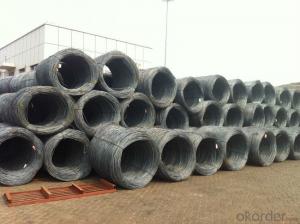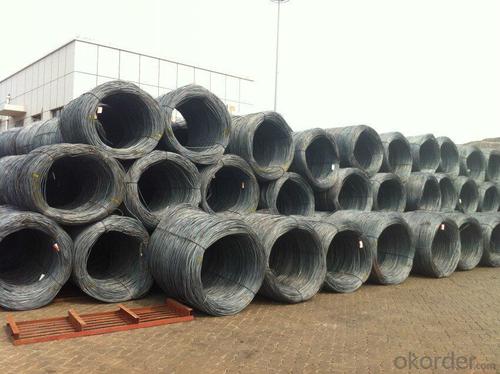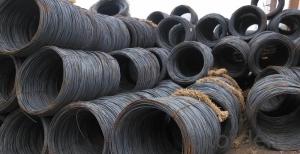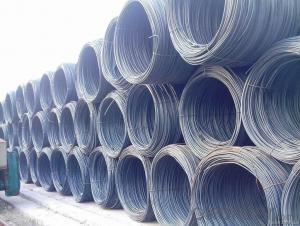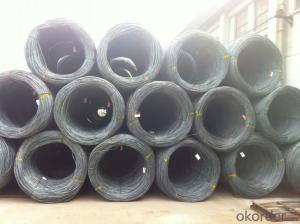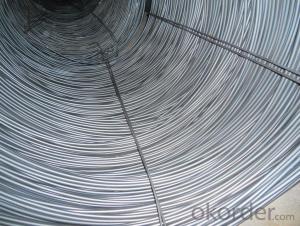New Arrival High Quality SAE1008 Steel Wire Rod
- Loading Port:
- Tianjin
- Payment Terms:
- TT OR LC
- Min Order Qty:
- 25 m.t.
- Supply Capability:
- 50000 m.t./month
OKorder Service Pledge
OKorder Financial Service
You Might Also Like
Specification
Steel Grade: Q195/235, SAE1006-1018B Standard: ASTM, GB
Diameter: 5.5mm, 6.5mm, 7mm,8mm,9mm,10mm,12mm,14mm
Type: Drawn Wire Alloy or Not: Alloy Brand Name: HSKY
Technique: Hot Rolled Place of Origin: China Mainland
Chemical Composition:(Please kindly find our chemistry of our material based on SAE1006B and SAE1008B as below for your information)
High carbon/Low carbon/common carbon Steel wire rod | With boron for rebate tax |
Grade | SAE1006B SAE1008B SAE1018B |
Package | In coil ,in bundle, |
Coil weight | about 2000kg-3000kgs |
Size: | 5.5mm 6.5mm 8mm 10mm 12mm 14mm 16mm |
Types | High Carbon ,Low carbon ,Common carbon |
Exported Country | South Korea,Vietnam,Indonesia,Myanmar,Philippines and Afrca,Ect |
Delivery term: | within 30 days after receive the LC |
Payment Term: | LC at sight ,LC 30-120 days after B/L date, TT payment |
The Standard of Physical Properties:
Grade | Chemical Composition(%) | |||||
C | Mn | Si | S | P | Cr | |
SAE1006 | 0.03~O.07 | ≤0.32 | ≤0.30 | ≤0.045 | ≤0.040 | >0.30 |
Mechanical properties | ||||||
Yield strength(N/mm2) | Tensile strength(N/mm2) | Elongation(%) | ||||
250-280 | 350-380 | ≥32 | ||||
Grade | Chemical Composition(%) | |||||
C | Mn | Si | S | P | Cr | |
SAE1008 | 0.10max | 0.3~O.50 | 0.15max | 0.050max | 0.040 max | 0.30 min |
Mechanical properties | ||||||
Yield strength(N/mm2) | Tensile strength(N/mm2) | Elongation(%) | ||||
≥195 | 315-430 | ≥30 | ||||
Usage and Applications of Steel Wire Rod in Coil:
After hot-rolled the products shaped into coil and delivery as finished product, including round, square, rectangular, hexagonal and so on, Since most of the products are round, it is generally called wire rod. Steel wire rod is widely used in construction and manufacturing. Steel wire rod is mainly used for reinforcement of reinforced concrete and welded structure or reprocessed (roberts, nail etc) materials, especially used to produce wire drawing, welding electrode, nails,spring, electronic, precise machinery parts and so on.
Packaging & Delivery of Steel Wire Rod in Coil:
Packaging Detail: products are packed in coil and then shipped by container or bulk vessel
Each coil weight: 2-3MT
Delivery Detail: within 45 days after received deposit or LC.
Label: to be specified by customer, generally, each bundle has 1-2 labels
Trade terms: CFR, CIF
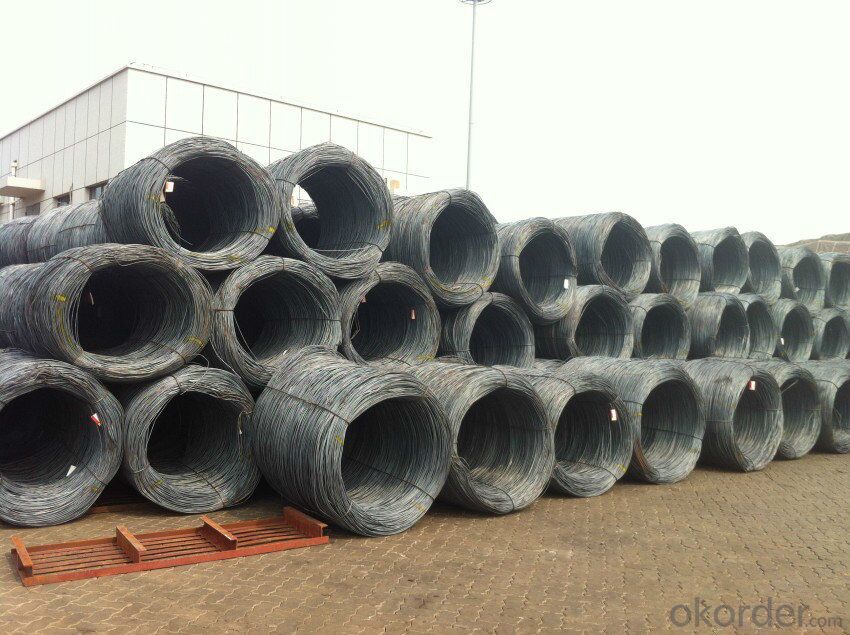
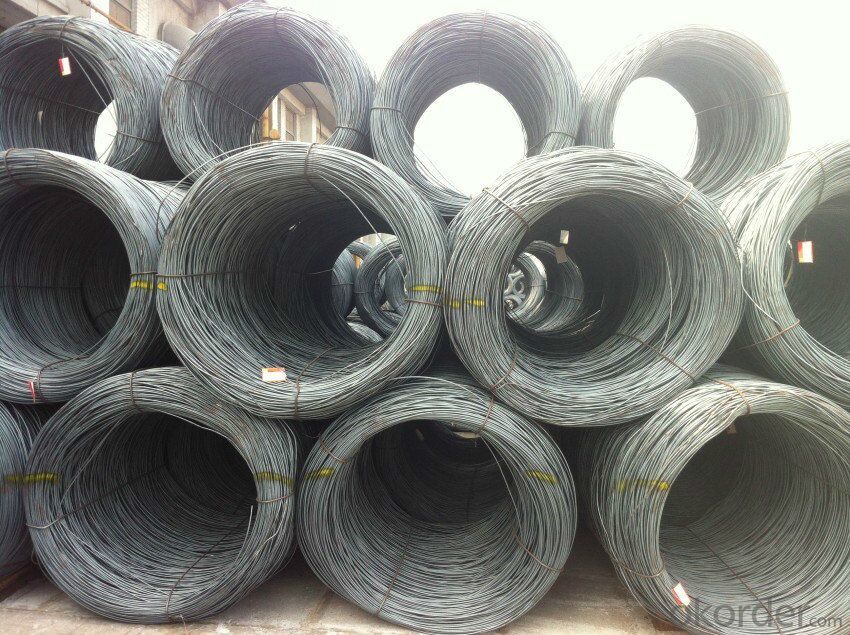
- Q: How is steel wire rod used in the production of nails and screws?
- Steel wire rod is a crucial raw material in the production of nails and screws. It is mainly used as the base material to manufacture these fasteners due to its exceptional strength and durability. The steel wire rod is first processed through a series of mechanical and heat treatments to enhance its properties. In the nail production process, the steel wire rod is first drawn through a wire drawing machine to reduce its diameter and increase its length. This process also improves the wire's tensile strength and smoothness. The drawn wire is then cut into specific lengths, and the ends are sharpened to form the nail points. Once the nails are formed, they undergo a heat treatment process known as tempering. This process involves subjecting the nails to high temperatures and then rapidly cooling them to increase their hardness and resistance to bending or breaking. The tempering process ensures that the nails can withstand the stress and pressure they will endure during use. Similarly, in the production of screws, the steel wire rod is drawn and cut into specific lengths. These lengths are then threaded by rolling or cutting grooves along the wire's surface, creating the spiraled shape of the screw. The threading process provides additional strength, allowing the screw to securely fasten materials together. The steel wire rod used in nail and screw production is typically made from low-carbon, high-carbon, or alloy steel. Each type of steel offers specific properties, such as corrosion resistance or increased strength, depending on the intended application of the fasteners. Overall, steel wire rod is an essential component in the production of nails and screws. Its strength, durability, and versatility make it an ideal material for these fasteners, ensuring they can effectively hold materials together in various construction, manufacturing, and household applications.
- Q: What are the different types of steel wire rod surface defects after wire drawing?
- After the wire drawing process, steel wire rods can exhibit several types of surface defects. These defects can be categorized based on their appearance and causes. 1. Scratches: Linear marks on the wire rod's surface can arise during the drawing process. They typically occur due to abrasive particles or contact with sharp edges of the drawing dies. 2. Scale: The wire rod's surface may develop a thin layer of oxide, known as scale, during the heating and rolling stages. Scale can create an uneven and rough surface, impacting both appearance and performance. 3. Pitting: Small depressions or pits can be observed on the wire rod's surface as pitting defects. They usually result from localized corrosion or uneven cooling during manufacturing. 4. Flakes: Irregularly shaped, thin pieces of metal that detach from the wire rod's surface are referred to as flakes. Excessive friction between the wire rod and the drawing dies often causes this detachment. 5. Decarburization: High temperatures during manufacturing can lead to a reduction in carbon content on the surface, resulting in decarburization. This can weaken the structure and mechanical properties of the wire rod. 6. Laps: Irregularities on the wire rod's surface can occur due to folding or overlapping of material during the drawing process, known as laps. Laps can weaken the structure and contribute to premature failure. 7. Grooves: Deep and narrow channels, known as grooves, can be seen on the wire rod's surface. They may arise from uneven wear of the drawing dies or the presence of abrasive particles during drawing. 8. Coating defects: In certain cases, wire rods may have a protective coating applied to prevent corrosion. Coating defects can include peeling, blistering, or uneven application, which compromises the wire rod's corrosion resistance. It is crucial to acknowledge that these defects can impact the quality and performance of the wire rod. Manufacturers often implement various quality control measures and inspections to identify and rectify these defects, ensuring the production of high-quality wire rods.
- Q: How is the corrosion resistance of steel wire rod evaluated?
- Various methods and tests are utilized to assess the corrosion resistance of steel wire rod. One commonly employed technique is the salt spray test, which is also known as the ASTM B117 test. During this test, the steel wire rod is exposed to a controlled environment of saltwater spray for a specific duration. Subsequently, the wire rod is inspected for any indications of corrosion, such as rust or discoloration. Another approach employed to evaluate corrosion resistance is the electrochemical test, such as the measurement of polarization curves. This test entails immersing the steel wire rod in an electrolyte solution and administering a small electric current. The resultant polarization curve provides information regarding the rate of corrosion and the propensity of the wire rod to corrode. Moreover, visual inspection and microscopic examination of the wire rod's surface can be conducted to identify any signs of corrosion, such as pitting or surface roughness. These evaluations are often supported by various corrosion measurement techniques, including analysis of weight loss, measurement of corrosion potential, and determination of corrosion rate. To summarize, the corrosion resistance of steel wire rod is evaluated through salt spray tests, electrochemical tests, visual inspection, and microscopic examination. These evaluations furnish valuable information about the wire rod's capacity to withstand corrosion and ensure its suitability for diverse applications.
- Q: What are the different types of corrosion resistance tests conducted on steel wire rod?
- There are several different types of corrosion resistance tests that are commonly conducted on steel wire rods. These tests aim to determine the ability of the wire rod to resist corrosion in various environments. Some of the commonly used corrosion resistance tests for steel wire rods include: 1. Salt Spray Test: This test involves subjecting the wire rod to a continuous salt spray environment. The rod is placed in a chamber where it is exposed to a saline solution mist. The test measures the time it takes for the wire rod to show signs of corrosion, such as rust formation. 2. Humidity Test: In this test, the wire rod is subjected to a high humidity environment for a specific period of time. The humidity level is controlled, and the wire rod is evaluated for any signs of corrosion, such as oxidation or surface discoloration. 3. Cyclic Corrosion Test: This test involves subjecting the wire rod to repeated cycles of different corrosive environments, such as salt spray, humidity, and dry heat. The rod is exposed to these conditions in a controlled manner, and its resistance to corrosion is assessed based on the appearance and extent of corrosion after each cycle. 4. Electrochemical Corrosion Test: This test measures the corrosion potential and corrosion current of the wire rod using electrochemical techniques. The wire rod is immersed in a corrosive solution, and its response to an applied electrical potential is evaluated. This test provides insights into the corrosion behavior and performance of the wire rod. 5. Acid Resistance Test: This test evaluates the wire rod's resistance to acid corrosion. The rod is immersed in an acidic solution for a specified period of time, and its weight loss or surface appearance is measured to assess the extent of corrosion. 6. Pitting Corrosion Test: Pitting corrosion is a localized form of corrosion that can be particularly damaging. This test involves exposing the wire rod to a corrosive environment where pitting corrosion is likely to occur. The rod is then examined for the presence and extent of pits using visual inspection or microscopy. These are just a few examples of the corrosion resistance tests conducted on steel wire rods. Each test provides valuable information about the wire rod's ability to withstand corrosion in specific conditions, helping to ensure its suitability for various applications.
- Q: What are the different decarburization testing methods for steel wire rod?
- There are several decarburization testing methods that are commonly used for steel wire rod. These methods are designed to determine the depth and extent of decarburization in the steel wire rod. 1. Macro examination: This method involves visually inspecting the surface of the steel wire rod for signs of decarburization. The rod is cut and polished, and then examined under a microscope to determine the depth and severity of decarburization. 2. Micro examination: Similar to macro examination, micro examination involves examining the surface of the steel wire rod under a microscope. However, this method provides a more detailed and magnified view of the decarburization. Micro examination allows for a more accurate measurement of the depth and extent of decarburization. 3. Chemical analysis: Chemical analysis involves taking a sample of the steel wire rod and analyzing its composition. This method can be used to determine the carbon content of the steel and compare it to the desired specifications. A higher carbon content indicates a lower level of decarburization. 4. Hardness testing: Decarburization can affect the hardness of the steel wire rod. Hardness testing involves measuring the resistance of the rod to indentation or penetration. A decrease in hardness can indicate the presence of decarburization. 5. Microhardness testing: Similar to hardness testing, microhardness testing involves measuring the hardness of the steel wire rod. However, this method uses a smaller and more precise indenter, allowing for a more accurate measurement of the hardness and the presence of decarburization. 6. Metallographic analysis: Metallographic analysis involves preparing a sample of the steel wire rod, polishing it, and then examining it under a microscope. This method allows for the observation of the microstructure of the steel and the presence of decarburization. These decarburization testing methods are essential in ensuring the quality and integrity of the steel wire rod. By using a combination of these methods, manufacturers can accurately assess the level of decarburization and take appropriate measures to maintain the desired quality standards.
- Q: What are the main factors affecting the recyclability of steel wire rod?
- The main factors affecting the recyclability of steel wire rod include the quality and composition of the steel, the presence of contaminants or coatings on the wire, and the efficiency and effectiveness of the recycling process used.
- Q: How is steel wire rod inspected for surface defects?
- The process of inspecting steel wire rods for surface defects involves two main methods: visual inspection and non-destructive testing. Trained personnel carry out the visual inspection, carefully examining the surface of the wire rod for any visible defects such as scratches, cracks, pits, or deformations. To ensure a thorough detection, proper lighting and magnifying tools are used. In addition to visual inspection, non-destructive testing techniques are used to further assess the quality of the wire rod. One commonly used method is magnetic particle inspection, where the wire rod is magnetized and a magnetic particle solution is applied on its surface. If there are any surface defects like cracks or discontinuities, the magnetic particles will cluster together, making the defect visible. Another method employed is ultrasonic testing, which involves transmitting high-frequency sound waves through the wire rod. Any internal or external defects will reflect these waves back, enabling the inspector to detect and measure the size and depth of the defects. Furthermore, eddy current testing is another non-destructive technique utilized for surface inspection. This method involves inducing an electric current in the wire rod and measuring the resulting magnetic field. Any surface defects will cause changes in the magnetic field, which can then be detected by the inspection equipment. Overall, a combination of visual inspection and non-destructive testing methods is used to ensure that steel wire rods undergo a thorough inspection for surface defects. This ensures that consumers receive a reliable and high-quality product.
- Q: How is the dimensional accuracy of steel wire rod measured?
- The dimensional accuracy of steel wire rod is typically measured using various techniques and tools to ensure that the dimensions of the rod meet the required specifications. Some commonly used methods to measure the dimensional accuracy of steel wire rod include: 1. Calipers: Calipers are used to measure the diameter of the steel wire rod. They can be either manual or digital, and they provide accurate readings by tightly gripping the rod and measuring its diameter. 2. Micrometers: Micrometers are precise measuring tools used to measure the diameter of the steel wire rod. They provide highly accurate readings by using a calibrated screw mechanism to measure the dimensions. 3. Optical measurement systems: Optical measurement systems use advanced technology, such as lasers or cameras, to measure the dimensions of the steel wire rod. These systems provide accurate and quick measurements by capturing multiple data points and analyzing them to determine the dimensional accuracy. 4. Ultrasonic measurement: Ultrasonic measurement techniques involve emitting ultrasonic waves into the steel wire rod and analyzing the reflected waves to determine its dimensions. This method is especially useful for measuring the thickness and cross-sectional dimensions of the rod. 5. Automated measurement systems: Automated measurement systems utilize specialized equipment and software to measure the dimensional accuracy of steel wire rods. These systems can provide accurate and repeatable measurements by employing robotics, sensors, and image processing algorithms. It is important to note that the specific measurement technique used may vary depending on the required dimensions, tolerances, and the capabilities of the manufacturer or testing facility.
- Q: What are the different types of steel wire rod defects that can occur during manufacturing?
- Some of the different types of steel wire rod defects that can occur during manufacturing include surface defects such as scale, cracks, and scratches, internal defects like inclusions, voids, and segregation, dimensional defects such as variations in diameter or ovality, and mechanical defects like twists, bends, or straightness issues. These defects can affect the quality and performance of the steel wire rod and may require proper inspection and quality control measures to prevent or minimize their occurrence.
- Q: What are the main factors influencing the choice of steel wire rod surface finish?
- The main factors influencing the choice of steel wire rod surface finish include the intended application of the wire rod, desired mechanical properties, corrosion resistance requirements, aesthetic considerations, and production costs.
Send your message to us
New Arrival High Quality SAE1008 Steel Wire Rod
- Loading Port:
- Tianjin
- Payment Terms:
- TT OR LC
- Min Order Qty:
- 25 m.t.
- Supply Capability:
- 50000 m.t./month
OKorder Service Pledge
OKorder Financial Service
Similar products
Hot products
Hot Searches
Related keywords
